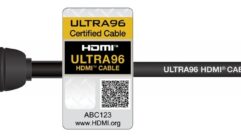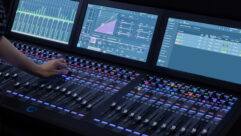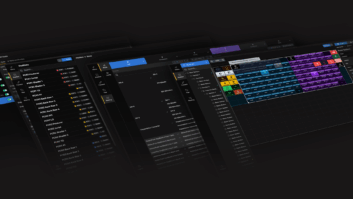
Houses of Worship — June 2, 2005
Jun 2, 2005 12:48 PM
Houses of Worship Top Story
Working in Worship Technology’s Gaps
Even at a large, well-known church with big-time production experience and a substantial budget, media ministers sometimes find themselves thinking wistfully of the tools they wish the AV industry would get around to providing. These are the tools that will enable them to do relatively commonplace things more easily, without having to commit to major investments in technological capabilities they don’t really need.
For Clifton Grimm, associate director of technical services at Southland Christian Church in Lexington, Ky., the biggest gaps in technology for worship users fall in the mid range between high-end, fully functional professional systems and less capable systems intended for those with smaller budgets.
Southland Christian is projecting digital video on four 16:9 screens in its 3,000-seat sanctuary, produces a TV program for local broadcast, and is equipped to stage major theatrical productions. Yet, Grimm says, “even with this level of video production, we’re still up against similar budget constraints as anyone else.”
Near the top of Grimm’s wish list is a simple way to dissolve images under a superimposed graphic or piece of text. “Where’s the affordable switcher with some basic effects, cuts, dissolves, the ability to key stuff—all in the $10,000 to $15,000 range?” he asks.
Converting computer generated graphics for 16:9 projection is another challenge, Grimm notes. “We’re still scan-converting all our VGA graphics,” he says. “We use a good scan converter, but still …”
Grimm adds that the church’s projectors can adapt and re-size computer images. “But we don’t have a graphic solution for it now,” he says. “There isn’t anything that even remotely begins to do it until you get into high-end character generators.”
Church media consultant and author Anthony Coppedge sees a similar disconnect between what users want and what’s available to buy. Often, users simply want the quality of a high-end system without a super-abundance of features they won’t use.
“A dual-scaler option at a reasonable price—$2,000 or $3,000” is how Coppedge describes one so-far-unavailable solution. This tool would allow text imposition over video as well as easier, more seamless image switching.
“People want to emulate what they see,” Coppedge says, “and that’s television. It doesn’t help that our marketeers continue to use phrases like ‘seamless switching.’ TV doesn’t freeze the image [when switching between channels]. TV doesn’t go black in between, and that’s just a $500 item.”
Among the things the church market needs most, Coppedge says, is “an answer to the issues of the ongoing cost of maintenance … [which means] a more efficient lamp technology … a replacement lamp for 100 bucks instead of 500.”
Developing a better, cheaper, longer-lived projection lamp is one approach to this quandary, Coppedge says. Another is finding new display tools that don’t need lamps at all. LED walls could fit into many church installs if they (and the image processing they require) weren’t so expensive. And new tools like organic LEDs could have a major impact. “If they can get this to work on a large scale, it’s going to revolutionize everything,” Coppedge predicts. This could possibly eliminate projectors, screens, and high-cost lamps all at once, he says.
This revolution, though, is still years in the future. Meanwhile, church media ministers continue to search for ways to accomplish their missions using what’s available, and working around the gaps.
Installation News
Single White Line-Array Solves Acoustic Problems in Sioux City
R & D Industries Inc. has achieved an acoustic and aesthetic success with its installation of a Nexo Geo S tangent array sound reinforcement system at the historic First Presbyterian Church of Sioux City, Iowa. An elegant single array of white Geo cabinets has brought intelligibility to this highly reverberant space.
The objectives of the First Presbyterian installation revolved primarily around the church’s choral music and speech intelligibility needs. Working closely with church personnel and volunteers, RDI made use of advanced acoustical modeling techniques to help determine the proper loudspeaker system configuration and placements, and, as a result, was able to work within the acoustical limitations of the room, providing a high degree of intelligibility for the speech applications despite the highly reverberant environment.
First Presbyterian was built in the early 1900s. The main sanctuary has a classic and timelessly simple design, with the pipe organ featured on the front wall facing a large balcony. This balcony overhang presented some unique challenges since it was basically removed from the main acoustical space, which made it very difficult to hear material from the original speaker system.
RDI solved this problem with under-balcony speakers. Three Nexo PS8s were employed to provide sound coverage in areas under the balcony. The main array’s design, however, did alleviate the need for upper-balcony delayed coverage, which would have been necessary with a conventional speaker system approach.
Using acoustical modeling, the design concept featuring a single array of Nexo Geo S showed sound pressure level deviations in the seating area were minimized in comparison to other designs considered. Says RDI project director Todd Berger, “This is a pretty reverberant space, so, by utilizing a line-array approach, we were able to alleviate a majority of the reflections from the hard-surfaced ceiling, keeping intelligibility relativley high.”
The array consists of seven S805s and two S830s hung at a height bumper bar of 33ft. The bumper bar down angle is -8.5 degrees and cabinets are splayed -2, -3.15, -5, -5, -5 ,-5, -5, -17.5, -17.5. The bottom S830 is the only box to use the CDD horn plate for 120-degree horizontal coverage. This provides adequate coverage in the balcony which is 74ft. back from the front of the cluster.
Todd Berger explains how this worked across the width of the sanctuary: “The space is actually only around 60ft. in width, so, using the included HF waveguide plates, we were able to provide narrow HF coverage for the portion of the array aimed toward the rear of the room and wider dispersion toward the near throw portion of the array. Due to the fact this system was designed for speech intelligibility, a central source point made sense to minimize interference from multiple sources. This particular congregation only uses the system for light music playback and vocal reproduction, so there was no call for subwoofers.
“The most appealing aspects of the GEO array were its physical size, precise directivity, the availability of a white finish—which allowed aesthetic impact to be minimized—and the cost-effectiveness for the client.”
Functionality of the system operation includes monitors for performers at the stage level, recording capabilities, and six channels of Shure UHF wireless microphones. Large diaphragm AKG stand mounted microphones are used for large-group recording as well as reinforcement, and Sennheiser handhelds were chosen for close vocal applications.
Marantz recording and playback electronics were installed and the system uses CX-series amplification from QSC throughout. Mixing is done by a Biamp Audia processor for the automatic mixing of speech applications as well as an Allen & Heath 32-channel mixing console for more complex tasks in manual mode. The loudspeaker processing was done using both an NX242 for the Geo S array and the PS8 TDcontroller for the underbalcony delays.
User-adjustable electronics are housed in a HSA rolltop equipment desk, stained to match its surroundings. This desk is located at the rear of the balcony and ensures operator sightlines. Core processing and amplification is located in a space adjacent to the sanctuary to help alleviate fan noise. This equipment is housed in a Lowell equipment rack with sequential power capabilities.
Auxiliary areas of the facility include a fellowship space that can be utilized either as overflow or independently from the sanctuary system, as well as a chapel that has the same “local source” and “sanctuary overflow” capability. The nurseries as well as the fellowship space have both audio and auxiliary video feed capability, delivering the worship experience to people removed from the sanctuary.

New Life Church Celebrates Dedication of New Auditorium and 20th Anniversary with Help from Aviom
With the opening of the new 7,500-seat auditorium at New Life Church in Colorado Springs, Colo., underway, Daryl Porter, chief audio engineer for New Life Church, turned to Aviom Inc., manufacturer of the A-Net Pro16 Monitor Mixing System, for a monitor system that could handle the church’s large praise band. The 11-piece band features drums, bass, keyboards, electric and acoustic guitars, strings, wind instruments, and a choir.
“The dedication ceremony was a big event for us since we were also celebrating our 20th anniversary,” says Porter. “The band had been using in-ear monitors (IEMs) on another system, but there were so many limitations. I found Aviom and immediately switched over to their system. The Aviom system is digital, runs on Cat-5 cable, and can have an unlimited number of stations. It’s a great piece of gear and does exactly what we need.”
Founded in 1985 by Ted Haggard, president of the 30-million member National Association of Evangelicals, New Life Church is currently the largest church in Colorado. The new facility is home to an 11,000-person congregation and holds four weekend services.
Porter, who has worked in the contemporary church market for a number of years, has noticed a tremendous change regarding the audio technology used for worship services. “Music is a big part of the worship experience at New Life Church,” he says. “We started using a few pieces of the Aviom gear in the old sanctuary and were very happy with it. In the new facility, incorporating the Aviom system has given us a much cleaner house sound.”
Aviom is the world’s leading creator of A-Net compatible Distributed Audio Network products, which provide innovative solutions to problems found in audio systems in a variety of environments. Some of these include live sound reinforcement, audio recording studios, houses of worship, theater, broadcast facilities, postproduction, and commercial installations. The company’s goal is to create revolutionary, technology-based products that address real-world needs and do it at breakthrough prices. Aviom’s entire line of high-quality professional audio products are designed and manufactured in the USA.
Product News

Allen & Heath Launches the Next Generation of Industry Standard GL Consoles
Allen & Heath will introduce the next generation of the industry-standard GL range at the NAMM Summer Session (Booth #1509, Indiana Convention Center, Indianapolis, July 22-24, 2005). The GL range now incorporates four new models: the GL2400, GL2800, GL3800, and GL4800 live sound consoles.
Based on dual-function capability, which Allen & Heath pioneered in the early 1990s, the range has been developed with a feature set dedicated to modern sound engineering, such as ambient matrix recording, fast IEM mixing, aux-fed sub, and engineer’s wedge monitor. To provide the best sound quality, the new GL models benefit from the latest audio circuit developments, a responsive “musically-tailored” EQ, extended preamp gain range of 74dB with input on XLR or jack, and a new ultra-quiet mix head amp design for optimum dynamic range.
Frame sizes vary from 16 to 56 channels, in all-metal space-saving frames that feature individual card and nutted pot construction; the GL3800 and GL4800 are also available in different combinations of mono and stereo channels. All models now include dual power supply capability, multi-function mic/line stereo channels, and an option for the Sys-Link V2 expander system.
“The new GL Series is designed to provide the best audio performance from analog technology. Without a doubt, this is our best-ever design in terms of sonic performance, and I firmly believe the audio quality rivals that of any desk,” says Allen & Heath’s head of design, Carey Davies. “Attention to detail is fundamental to our design ethos—whether deciding the position of a switch for quick access in a live show or the proper gain structure of the system from mic to speaker. Allen & Heath has sold 40,000 GL mixers since the range was launched in 1995. By enhancing the capability of the range, we are certain the GL Series will retain its status as the industry standard for all-purpose mixing.”
Further information on the company’s products can be found on the Allen & Heath website: www.allen-heath.com.

New Kramer Computer Graphics Video DAs Have Wide Compatibility
Kramer Electronics Ltd., a worldwide supplier of audio, video, and computer graphics signal distribution, switching and processing equipment for the broadcast, production, security, education, home theater, and ProAV presentation markets, is pleased to announce the newest additions to its product line—the VP-3xl, VP-4xl, and VP-5xl computer graphics video distribution amplifiers. These models have newly designed sync circuitry to ensure compatibility with the range of sync signal variances found in many of the PCs and displays in the market today.
The Kramer VP-3xl, VP-4xl, and VP-5xl are high-performance distribution amplifiers (1:3, 1:4, and 1:5) for computer graphics video signals. Each machine includes front panel EQ control to compensate for long cable runs and switches for ID Bit control. The machines have a video bandwidth in excess of 375MHz at (-3dB) fully loaded, making them compatible with computer graphics video resolutions from VGA through QXGA.
“In the market today it is a fact of life that many PCs and fixed resolution digital displays have subtle variances from what would be considered standard sync signal levels,” states Chris Kopin, vice president of Product Development for Kramer Electronics USA. “As a result, signal processing equipment such as our DAs must be designed to accommodate these wide variations in the sync signals they process, so that any PC or any display connected will operate flawlessly every time. The VP-3xl, VP-4xl, and VP-5xl have newly designed sync processing circuits that address this issue.”
The VP-3xl, VP-4xl, and VP-5xl each accept one input, provide necessary buffering and isolation, and then distribute the signal to each of its identical outputs. The machines have internal international power supplies and are housed in a half 19in. enclosure.
The Kramer VP-3xl, VP-4xl, and VP-5xl are now in stock and carry a list price in the United States of $350, $375, and $400 respectively.

TOA Releases New Speaker System Design Software
TOA Electronics Inc. has released version 1.4 of its free Speaker System Design Software, which includes additional speaker data files for its groundbreaking new HX-5 variable dispersion speakers. Boasting 3D layout views and colorful displays, the easy-to-use software enables designers to produce a speaker system layout in minutes. Other features include interactive frequency response plots, selectable frequency centers, recommended amplifier power, and more.
For more information or to download TOA’s Speaker System Design Software, Version 1.4, visit www.toaelectronics.com/speaker_software.asp or contact the Customer Service staff at 800-733-7088.
Upcoming Events
Sound Reinforcement for Operators and Sound Reinforcement for Technicians
Each seminar lasts two days and they are held back-to-back.
Syn-Aud-Con’s Seminar Schedule
Aug. 22-25, 2005 – Kansas City, Mo.
Oct. 17-20, 2005 – Secaucus, N.J.
Nov. 7-10, 2005 – ETS-LDI Show in Orlando, Fla.
Sound Reinforcement for Operators addresses the subjects that are essential for operating a sound system. This is a basic course, and the emphasis is on practical rather than theoretical learning, using real-world explanations of potentially complex subjects. Multimedia demonstrations drive the point home and convey a level of understanding that will help head off problems before they occur. The system operator is a vital part of the signal chain. Cost: $500
Sound Reinforcement for Technicians is for those who install, configure, and calibrate sound reinforcement systems. It covers the theory behind how systems work and demonstrates how to use instrumentation to look “under the hood” to troubleshoot systems. This technician-level course is for those who already know the basics of operation, but want to dig further into how systems work and how to fix them when they don’t. Price: $600; Take both Sound Reinforcement for Operators and Technicians: $1050
Sound Reinforcement for Designers
Sept. 19-22, 2005 – Salt Lake City, Utah
Sound Reinforcement for Designers integrates the art and science of room acoustics, measurement, and sound system design. The first two days cover the measurement and prediction of the acoustical performance of the enclosed space. Days three and four are devoted to a Sound System Design process that is based on the room’s acoustics. This course integrates room acoustics, acoustical measurement and system design into a single course that bonds them together in a practical, meaningful way. It is also a valuable course for anyone who owns an acoustic measurement system and wants to learn how to get good room data in an accurate and efficient way. Price: $1100
For detailed information on the seminars, please visit this link: www.synaudcon.com/sched.htm










